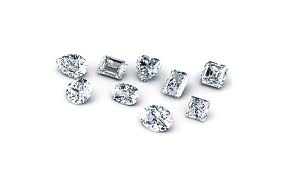The first thought that comes to mind when you are considering buying a diamond is “What shape do I want?” The shape is the most obvious characteristic of the diamond and observed immediately at a mere glance. There are 10 diamond shapes that are considered to be the most common – including round, oval and pear. Whilst some of the shapes’ names are self-explanatory, others, such as the Asscher and Marquise, may require some illumination. Learn more about diamond shapes in our Diamond Education Guide.
Once you have chosen the diamond shape for your jewellery, the following points to consider are the diamond’s quality and size. Having a budget means you can explore your options within the parameters of what you are prepared to pay for.
 A diamond’s quality and price hinges on the 4 Cs – Cut, Colour, Clarity and Carat. Of the 4 Cs, the cut of the diamond is paramount in terms of the diamond’s vivacity and shine. A poor cut will render even a flawless white diamond dull and lifeless. The colour of the diamond you opt for will be influenced by the item of jewellery you are having made. A solitaire diamond engagement ring, for example will appear more attractive with a diamond of a higher colour grade, whereas a lower colour grade diamond may be sufficient for earrings or pendants. You should also take into account the colour of the metal your diamond will be set in. White gold or platinum work best with higher colour grades whilst yellow gold disperses the yellowish appearance of lower colour grades. The clarity of a diamond refers to inclusions within it. Whilst these inclusions may decrease the value of a diamond, bear in mind that the majority of these imperfections are invisible to the naked eye. Finally, carat is the measure of a diamond’s weight and gives a fair, though not accurate indication of the diamond’s size. Choosing a higher carat of diamond when adhering to a budget may mean you have to compromise the cut, colour and clarity. It is a matter of preference whether you choose quality over size or vice versa. Read further about the 4 Cs in the Learn About Diamonds section of our website.
A diamond’s quality and price hinges on the 4 Cs – Cut, Colour, Clarity and Carat. Of the 4 Cs, the cut of the diamond is paramount in terms of the diamond’s vivacity and shine. A poor cut will render even a flawless white diamond dull and lifeless. The colour of the diamond you opt for will be influenced by the item of jewellery you are having made. A solitaire diamond engagement ring, for example will appear more attractive with a diamond of a higher colour grade, whereas a lower colour grade diamond may be sufficient for earrings or pendants. You should also take into account the colour of the metal your diamond will be set in. White gold or platinum work best with higher colour grades whilst yellow gold disperses the yellowish appearance of lower colour grades. The clarity of a diamond refers to inclusions within it. Whilst these inclusions may decrease the value of a diamond, bear in mind that the majority of these imperfections are invisible to the naked eye. Finally, carat is the measure of a diamond’s weight and gives a fair, though not accurate indication of the diamond’s size. Choosing a higher carat of diamond when adhering to a budget may mean you have to compromise the cut, colour and clarity. It is a matter of preference whether you choose quality over size or vice versa. Read further about the 4 Cs in the Learn About Diamonds section of our website.
When you have decided upon your budget and ideal diamond, the next step is to view a range of diamonds reflecting your criteria. Having the characteristics of each diamond explained will allow you compare the differences. You will thus gain a more concrete understanding of the 4 Cs and the impact they have on the price of the diamond.
Before you purchase a diamond, make sure that you view the Diamond Grading Certificate. This document authenticates a diamond’s dimensions and characteristics. It is critical the certificate is issued by an independent and reputable laboratory, such as GIA (Gemmological Institute of America), GSL (Gem Studies Laboratory) or DCLA (Diamond Certification Lab of Australia). A certificate issued by an actual retailer may not be an accurate report of the diamond.
At Raffini Jewellers we are proud to offer you expert advice and reputable service when it comes to selling loose diamonds. We cater for all budgets and by dealing directly through our workshop, you will receive the most competitive price on the market. Raffini Jewellers arrange for an independent diamond grading certificate with all diamonds over 0.30ct.